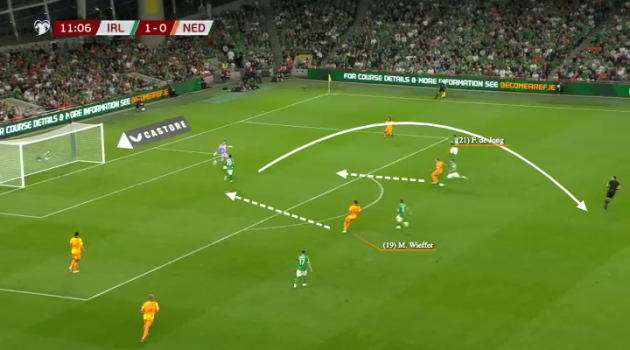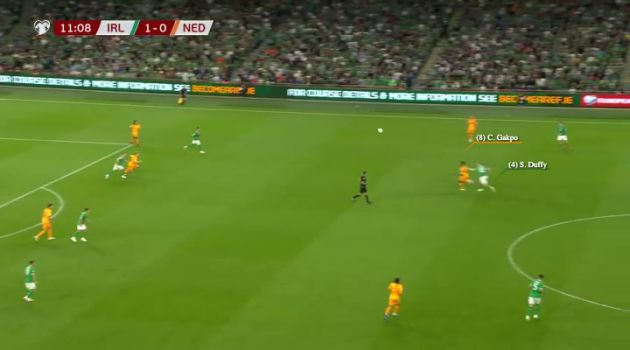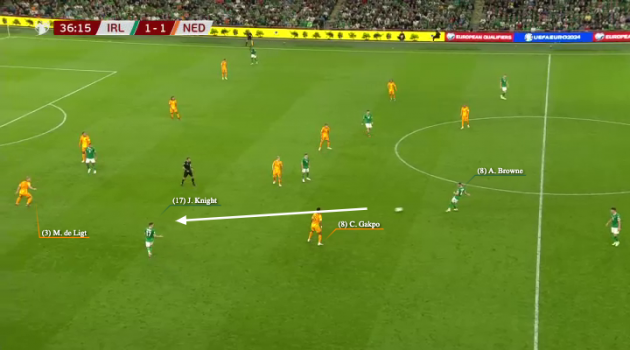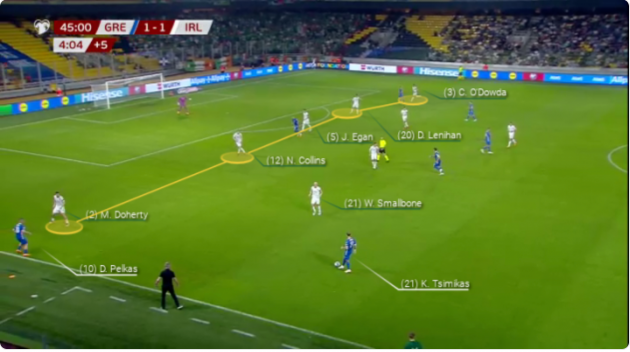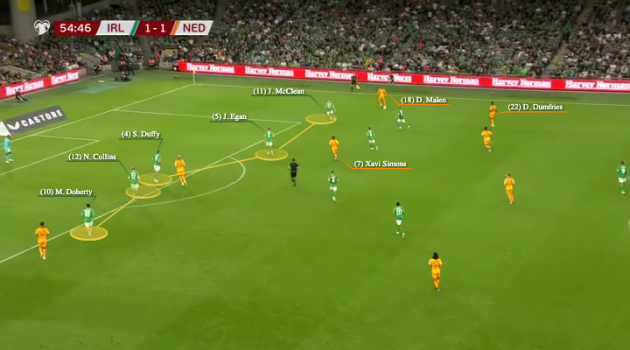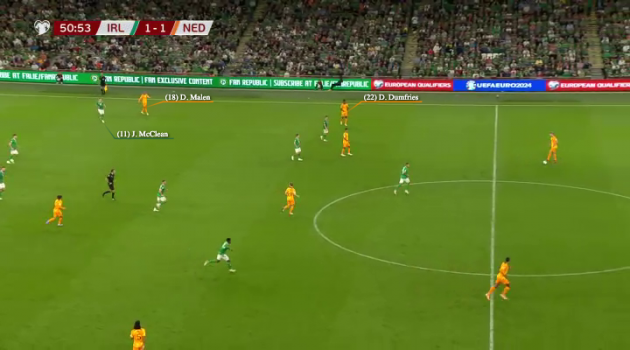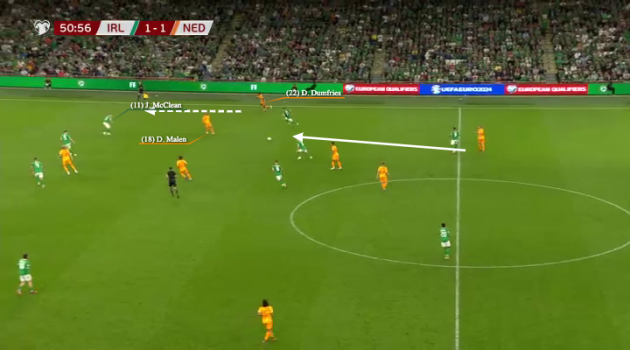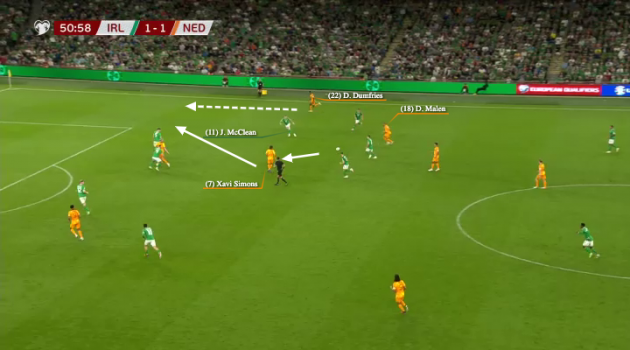IRELAND’S HOPES OF taking the front door route to the Euros are dead following a fourth defeat in five games, a 2-1 defeat at home to the Netherlands the fourth and final nail. The disappointment is not necessarily in the fact Ireland’s hopes are dashed but that they have been dashed so soon.
Losing to France and the Netherlands by an aggregate of four goals across three games is no sign of obvious underperformance, but the 2-1 loss to Greece in Athens was the campaign’s death-mark.
We are now in an appalling state of liminal apathy, waiting for every other result around Europe to determine whether we will squeeze into the play-offs.
There were echoes of that Greek defeat in last night’s loss, and if Stephen Kenny does get more time in the job, there is accumulating evidence he needs to stray from his initially successful but ultimately exposed back-three system.
Having been elevated to the role off the back of a 4-3-3 that showcased his principles at Dundalk, Kenny’s appalling run of form at the start of his tenure saw him change to a back three from the start of 2021. It largely worked across that campaign – Luxembourg at home aside – and remained effective when tweaked from 3-4-3 to 3-5-2 in the Nations League. But while it did a a fine job of containing the French in March at the start of this daunting group, but it has been picked apart since. First by Greece and, last night, by the Netherlands.
Ireland’s fast start
Ireland’s start last night was fast and furious, with Alan Browne rendering a more effective version of Keane-on-Overmars by pressing Frenkie de Jong on a short kick by goalkeeper Mark Flekken and forcing a corner, from which Ireland won the penalty with which they took the lead.
Ireland pressed high and they pressed man-to-man, with the outstanding Browne consistently pilfering De Jong’s pocket as Ogbene, Idah, Knight and Cullen stuck to Ake, Van Dijk, De Ligt, and Wieffer respectively. Browne’s pressing yielded two glorious chances: the first ended up in a penalty, but the second was wasted by Ogbene, who dallied too long on his shot. It was the first point of the week in which you could truly bemoan Evan Ferguson’s absence.
In the opening exchanges, Ireland took few risks in possession, playing a lot of long balls. Just shy of 20% of Ireland’s passes in the opening 15 minutes travelled further than 25 metres, which is just less than twice as often as Ireland have averaged on the same metric across all games in the last 12 months.
While the Dutch defenders won almost all of these balls in the air, Browne, Knight and Cullen’s industry meant they generally sprinted forward to collect the second ball. (Kenny noted that Ireland’s energy faded in the second-half, and perhaps this was one of the reasons why.)
But given Ireland were evenly-matched numerically in midfield, this was the percentage – and correct – tactic. Better to go over a midfield if you know you can’t play through them.
Netherlands settle
The Dutch, however, settled and then figured a way around Ireland’s high press, for which they owed gratitude to Cody Gakpo. Frequently, De Jong and Wieffer drew the Irish midfield forward to leave space for Gakpo to come in off the left to collect the ball in front of Ireland’s back three.
The Dutch front three played very narrowly and close together, and some of their interplay was brilliantly slick. And as Ireland pushed their midfield duo and wing-backs very high, it left their back three one-v-one against Gakpo, Donyell Malen and Xavi Simons. This is a hardly typical means of playing against the Netherlands, but it was a consequence of Ireland’s need to win the game, and pressing high worked in getting Ireland’s first goal. There were naturally a couple of high-wire moments, and twice Malen sprinted clear only to be denied by Gavin Bazunu.
The Dutch equaliser came again from Gakpo’s roving role, albeit this time he intercepted a poor Doherty header, who himself had moved up to read an errant van Dijk switch of play.
Ireland were then caught too open, with McClean pushed too high to track Dumfries’ excellent run, while Duffy read Malen’s dummy run and wiped out any hopes of catching the Dutch wing-back offside.
Ireland wrestle the game back
Ireland played some of their best football after the equaliser, genuinely moving the ball through the thirds and playing fewer long balls. For this they owed an enormous debt to Jason Knight, who cleverly dropped off De Ligt and into space between the lines. He frequently got into positions like these…
…but the frustrating aspect of this for Ireland was the lack of support around him. Balls in behind for Idah were defended well while McClean, perhaps hindered by recent injury, struggled to link-up with Knight and dribble by the excellent Dumfries down the left touchline and open the pitch up.
It is in these situations Kenny would prefer Callum O’Dowda to McClean, but the latter is much more reliable defensively. Enda Stevens, who perhaps has a balance of both attributes, has had his last 15 months blighted by injury.
Meanwhile, Matt Doherty – whom this system should suit above all – struggled to get to the pitch of the game, which is unsurprising given his lack of match minutes. Doherty’s move from Wolves to Spurs months after Kenny swapped to a back three has proved to be a disaster. Doherty has played just 5,331 minutes of competitive first-team football at club level since the start of the 2020/21 season, having played 4,325 minutes in the 2019/20 season alone.
If Ireland do not have enough thrust and athleticism at both wing-back positions, it’s hard to make a case for the retention of the system.
Koeman makes the decisive move
It was Ronald Koeman who was first to discard his back three, however. He brought in Wout Weghorst as part of a double change at the break and reverted to a 4-3-3/4-2-3-1.
“It was a good decision”, said Koeman afterwards and his self-praise was justified. Ireland were utterly dominated for the first 15 minutes of the second half and it was in this period they ultimately lost the game.
To return to the earlier point about there being no secrets in international football: the Dutch won the game by doing to Ireland what Greece had done in June. Koeman put his wingers high and wide, with Malen going to the right and Gakpo to the left, allowing Dumfries drop into right-back which counter-intuitively made him more dangerous.
Ireland repeated their mistakes from Athens. Rather than have their wing-backs push up and press the opposition full-back, they were instead held in check by the Dutch wingers, which meant Ireland were pushed way back, with no way out.
Compare and contrast this pattern back in June…
…with this set-up from last night.
The Dutch, though, offered much more quality than Greece. With Ireland dragged deeper, De Jong took a step back himself and then ran the game. They concentrated all of their attacks down their right flank, but Malen stood wide and then dropped inside to create space for the overlapping Dumfries. With McClean attracted to Malen, Dumfries was left too open too often.
An example: Browne ultimately makes a heroic block on Simons to prevent a Dutch goal shortly after half-time, but the move’s genesis involved Malen and Dumfries.
And it was that side of the pitch that yielded the goal: again, McClean, concerned with Malen, allows Dumfries ghost in behind. It would not have mattered had Duffy stepped up to play offside, but, regrettably, he did not.
There were times when it felt Ireland had a superfluous body among their backline: Egan needed to tag Malen and allow McClean drift out to concentrate on Dumfries. But, perhaps unnerved having been left one-on-one with Malen in the first-half, that didn’t happen. Playing a back four would at least have the benefit of yielding the match-ups we saw last night but with an extra body in midfield, capable of either curbing De Jong’s influence or giving Ireland an outlet from pressure.
Ireland swapped from a 3-4-3 to a 3-5-2 just after the goal, dropping Knight deeper into midfield, asking him to track Dumfries. This largely worked but it further blunted Ireland’s attack, and at one point left them in a flat back six.
Ireland adapt but lack the quality to score
But unlike in Athens, Ireland changed their system entirely. First Ryan Manning went to left wing-back in a straight swap with McClean, and then Will Smallbone and Jamie McGrath came on as Ireland went 4-2-3-1.
Ireland then hogged possession but simply did not have the quality on the pitch to hurt a Dutch side who were happy with a 2-1 win, with some of Manning’s deliveries from the left-hand side particularly disappointing. Van Dijk, having looked vulnerable on the ground in the opening stages, was imperious in the air, easily dealing with whatever Ireland slung his way.
There is an air of inevitability gathering around Stephen Kenny now, though he may get a chance to see out the campaign. And if the next couple of months are to be his last in the job, then perhaps he will revert to the system with which it all started.
Knight and Browne have emerged as viable candidates to play as left and right-sided eights in a 4-3-3, while Mikey Johnston’s arrival and Chiedozie Ogbene’s emergence means Ireland finally have genuine, pacy wingers capable of providing chances for Evan Ferguson. It was the lack of that profile of player that tempted Kenny into a change in the first place.
When it comes to player development – the key component in all of this – Ireland are playing catch-up on the rest of Europe, but when it comes to best utilising the players of the here and now, you must evolve merely to stand still.


